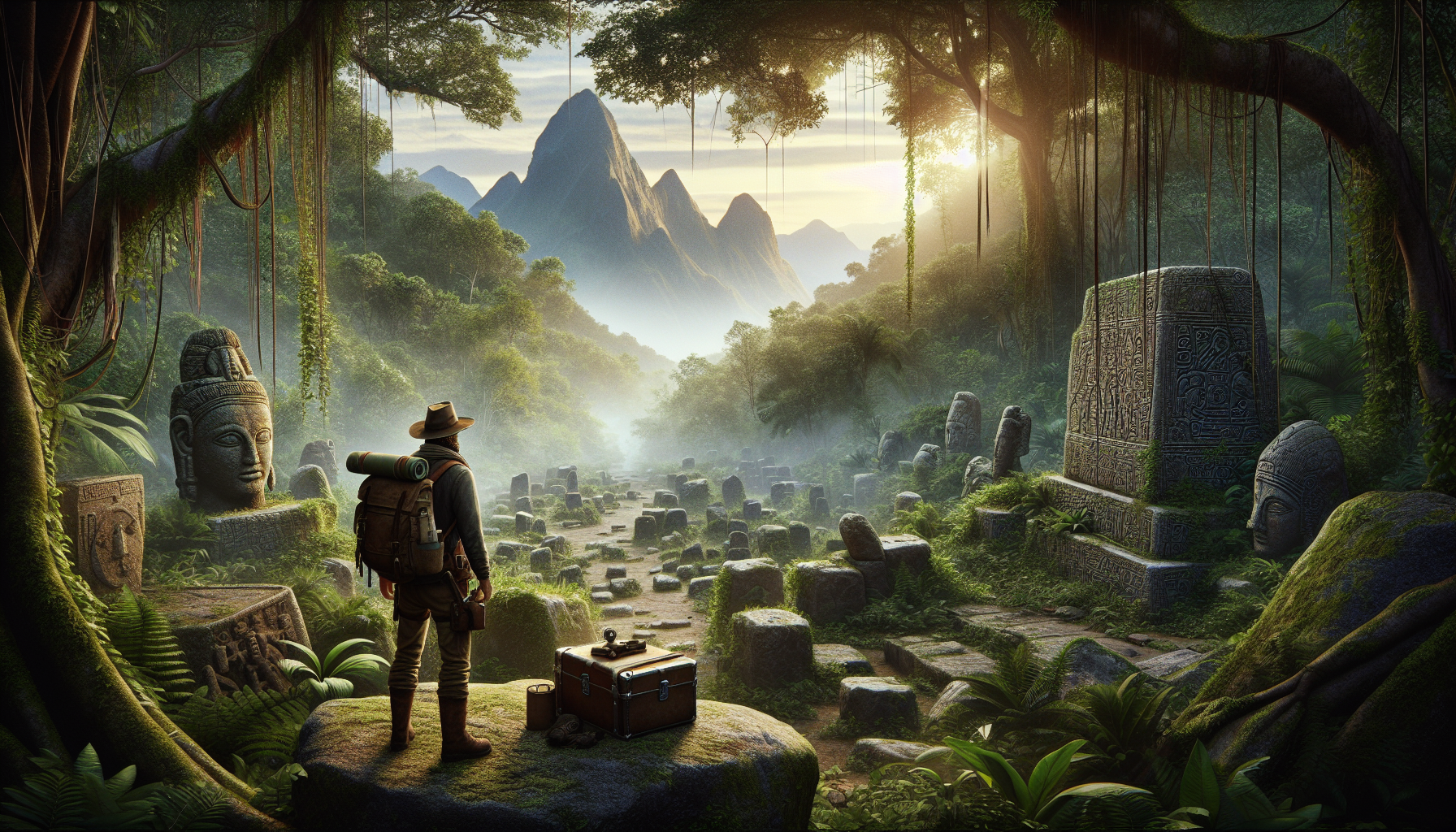In a world where the boundaries of our understanding are constantly expanding, few topics ignite the imagination quite like the mysteries of lost continents. Among these enigmatic lands, the tales of Lemuria, often referred to as the lost continent of the Indian Ocean, stand out as particularly captivating. As we embark on this journey to uncover the secrets of Lemuria and other ancient civilizations, we delve into a rich tapestry of myths, scientific theories, and cultural narratives that span across centuries and continents. This exploration invites us to question what we know about our planet’s history and to consider the tantalizing possibility that entire civilizations may have risen and fallen, leaving behind only whispers of their existence.
The story of Lemuria is steeped in intrigue, woven from the threads of ancient legends, speculative science, and the remnants of forgotten cultures. First proposed in the 19th century as a theoretical land bridge to explain the distribution of lemurs and other species across Madagascar and India, Lemuria captured the imaginations of scientists and mystics alike. As we journey through the narrative of Lemuria, we’ll explore its origins in the scientific debates of the time, the cultural and spiritual dimensions it has inspired, and the enduring fascination it holds for modern seekers of the unknown. Alongside Lemuria, we’ll traverse the stories of other purported lost lands, such as Atlantis and Mu, drawing connections and contrasts that illuminate the human desire to uncover the mysteries of our past.
The Enigmatic Tale of Lemuria
In the vast expanse of historical and geological speculation, few stories capture the imagination quite like the legend of Lemuria. This hypothesized “lost continent” is believed by some to have once bridged the Indian Ocean, linking Madagascar and India. The notion of Lemuria originated in the 19th century when geologists speculated about the peculiar distribution of lemur fossils across these distant lands. Scientists like Philip Sclater pondered how similar species could exist in such separated geographical areas without a land connection in the past. Though modern science attributes these similarities to plate tectonics and continental drift, the myth of Lemuria has persisted, weaving itself into the fabric of popular culture and pseudoscience.
Enthusiasts of lost continents often paint a vivid picture of Lemuria as a civilization of advanced beings, knowledgeable in science and philosophy, with achievements rivaling those of other ancient civilizations. Stories abound of its rich culture, spiritual wisdom, and eventual demise, often attributed to cataclysmic events like earthquakes or floods. While mainstream academia does not recognize Lemuria as a factual entity, the legend persists, inspiring books, movies, and even religious movements.
The fascination with Lemuria is not just an academic curiosity but reflects humanity’s broader quest to understand our planet’s past. It challenges us to think critically about the sources of knowledge and the lines between scientific theory and myth. For those drawn to the mysterious, Lemuria serves as a potent reminder of the uncharted territories of our imagination. Below is a fascinating video that delves deeper into the mysteries surrounding Lemuria. Watch to explore more about this enigmatic story:
Watch this intriguing video on Lemuria: The Lost Continent of Lemuria: Truth or Myth? – Ancient Mysteries
Comparative Analysis of Lemuria and Atlantis
While Lemuria captures the imagination with its mysterious allure, it often draws comparisons to another legendary lost continent: Atlantis. Both are said to be advanced civilizations that met with catastrophic ends, yet their stories diverge in intriguing ways. Atlantis, first mentioned by the Greek philosopher Plato, was described as a powerful and technologically advanced civilization that succumbed to moral decay, leading to its downfall. In contrast, Lemuria’s downfall is often attributed to natural disasters rather than human failings.
The narratives of these lost continents reflect different aspects of human curiosity and fear. Atlantis serves as a cautionary tale about the hubris of civilizations, whereas Lemuria often symbolizes the lost wisdom and untapped potential of ancient peoples. The table below provides a comparative analysis of these two legendary lands, illustrating both their similarities and distinctions.
| Aspect | Lemuria | Atlantis |
|---|---|---|
| Origin | Hypothesized by 19th-century scientists | First mentioned by Plato |
| Geographical Hypothesis | Indian Ocean, between Madagascar and India | Atlantic Ocean, beyond the “Pillars of Hercules” |
| Civilization Characteristics | Spiritually advanced, philosophical | Technologically advanced, powerful |
| Cause of Destruction | Natural disasters like earthquakes | Moral decay and resulting cataclysm |
Beyond their roles as mythological icons, Lemuria and Atlantis serve as reminders of the delicate balance civilizations must maintain with their environments and values. Their legends urge us to ponder the possibilities of undiscovered histories and challenge us to be stewards of our own civilization’s future.
The Scientific Perspectives on Lost Continents
Modern science has provided insights into the possibility of lost continents, though it does not support the myths of Lemuria or Atlantis in their traditional forms. Advances in geology, particularly the theory of plate tectonics, have offered explanations for the distribution of species and geological formations that initially gave rise to the idea of Lemuria. According to this theory, the Earth’s lithosphere is divided into tectonic plates that have shifted over millions of years, carrying continents to their current positions. This movement explains the separation of species and the similarities in geological formations across continents.
Recent scientific discoveries have identified real submerged landmasses that could be considered “lost continents” in a geological sense. For example, the microcontinent of Zealandia, mostly submerged beneath the Pacific Ocean, was only recognized as a continent in recent years. These findings suggest that while the legends of Lemuria and Atlantis may not have a factual basis, the concept of lost landmasses is not entirely out of the realm of possibility. These discoveries continue to fuel speculation and inspire scientific inquiry into Earth’s ancient geological past.
For those interested in exploring the scientific explanations behind these myths, the video below provides an insightful analysis of plate tectonics and their role in shaping the Earth’s continents. Be sure to watch and expand your understanding of how the Earth has evolved over millennia:
Explore the science of plate tectonics: Plate Tectonics Explained – The Basics – Geography – Science Channel
The Role of Technology in Uncovering Ancient Mysteries
Technology has been instrumental in advancing our understanding of ancient civilizations and lost continents. From satellite imagery to deep-sea exploration, modern tools have revolutionized archaeology and geology, allowing us to uncover evidence that was once hidden beneath the earth or sea. These technological advancements have led to the discovery of submerged cities, ancient artifacts, and even entire landscapes that challenge our understanding of historical timelines and cultural development.
One example of technology’s impact is the use of LiDAR (Light Detection and Ranging), which has uncovered hidden structures beneath dense jungle canopies in regions like Central America. This non-invasive technique provides detailed maps of the Earth’s surface, revealing the remains of ancient cities that were previously inaccessible. Such discoveries have deepened our understanding of ancient societies and have the potential to rewrite history books.
As technology continues to evolve, it opens new avenues for exploration and discovery. While the myths of Lemuria and Atlantis may remain unproven, the tools we develop today may eventually uncover the truths hidden in the legends of lost worlds. As you ponder these possibilities, consider how technological innovations might continue to reshape our understanding of the ancient world.

Conclusion
Uncovering the mysteries of lost continents like Lemuria and other ancient civilizations provides us with a fascinating glimpse into the past, challenging our understanding of history, geography, and human development. Throughout this article, we have journeyed through various aspects of these enigmatic stories, highlighting the historical context, scientific exploration, and cultural significance of these lost worlds. This exploration not only fuels our imagination but also enriches our appreciation for the complex tapestry of human history.
The discussion began with an examination of Lemuria, a hypothetical continent proposed in the 19th century by geologists to explain geological and biological anomalies in the Indian Ocean region. Although modern science has largely discredited the existence of Lemuria as initially imagined, the story remains compelling, offering insights into how scientific theories evolve and how they can inspire cultural myths and legends.
We further explored the role of other ancient civilizations, such as Atlantis and Mu, drawing parallels and contrasts between these myths and their cultural impacts across different societies. These stories, regardless of their factual accuracy, continue to captivate us, offering a rich source of inspiration for literature, art, and popular culture. By delving into these tales, we uncover how civilizations have historically sought to understand their origins and the mysteries of the world around them.
A key takeaway from our exploration is the role of scientific advancements in shaping our understanding of history. From early geological hypotheses to modern tectonic plate theories, science plays a crucial role in unveiling the mysteries of our planet’s past. The story of Lemuria underscores the importance of scientific inquiry and critical thinking, encouraging us to question, explore, and continually expand our knowledge.
Furthermore, the cultural significance of these lost continents cannot be understated. They remind us of the human propensity to create narratives that explain the unknown, highlighting our deep-seated desire to connect with our past and make sense of the present. These stories, whether grounded in fact or fiction, serve as a testament to the power of imagination and storytelling in shaping human culture.
In conclusion, the exploration of lost continents like Lemuria and other ancient civilizations is more than just a historical curiosity; it is a journey into the heart of human creativity, scientific inquiry, and cultural expression. The stories we tell about these lost worlds reveal as much about ourselves and our societies as they do about the civilizations they describe.
As we close this exploration, I invite you to reflect on the mysteries we’ve uncovered and consider their implications for our understanding of history and culture. Share your thoughts, comments, and any additional insights you may have. By engaging in this dialogue, we continue the tradition of inquiry and exploration that these ancient stories inspire. 🌍✨
If you’re interested in delving deeper into the subject, numerous resources are available that explore the intersections of myth, history, and science in more detail. For a more comprehensive understanding, consider visiting reputable sources such as the Smithsonian Institution’s Lost Continents and the Myths They Inspire and the Geological Society’s Historical Perspectives on the Lost Continents. These resources provide valuable insights and further reading on this captivating subject.
Thank you for joining us on this fascinating journey through time and imagination. Let’s continue to explore, question, and learn from the mysteries that surround us, keeping the spirit of discovery alive. 🌌📚
Toni Santos is a visual storyteller and conceptual archivist whose work explores the curious, often poetic ruins of pseudoscience and obsolete theories. With a reverence for forgotten frameworks and fantastical logic, Toni illuminates the imaginative spaces where science once drifted into myth, speculation, and symbolic belief.
His creative path is rooted in a fascination with the fringe — from phrenology maps to ether diagrams, hollow earth charts to animal magnetism illustrations. Each visual Toni creates or curates is an invitation to reexamine the strange beauty of discarded knowledge — not as failure, but as cultural reflection, as art born from our eternal desire to explain the unexplainable.
Blending visual design with historical inquiry, Toni gives new life to lost diagrams, metaphysical charts, and antique engravings that once shaped worldviews. His work occupies the liminal zone between fact and fiction, where obsolete models still pulse with philosophical resonance and forgotten charm.
As the mind behind Vizovex, Toni shares illustrated essays, curated collections, and visual reinterpretations that invite others to explore the aesthetic and symbolic value of outdated theories. His goal is not to validate, but to remember — to view these speculative systems as relics of human creativity, vulnerability, and yearning.
His work is a tribute to:
The elegance of error in the evolution of knowledge
The symbolic artistry of discarded explanations
The blurred lines between belief, observation, and imagination
Whether you’re a collector of curious ideas, a lover of forgotten diagrams, or someone drawn to the strange scaffolding of old worldviews, Toni opens a portal to a time when the universe was still full of ghosts, humors, and cosmic fluids — one chart, one symbol, one discredited wonder at a time.





